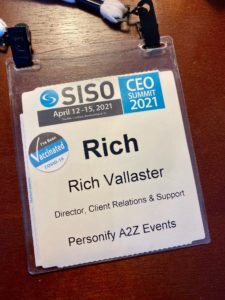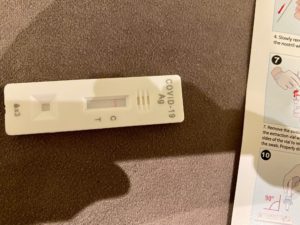
SISO CEO 2021 Name Badge
While it seemed like attending my first post-pandemic in-person event would be like riding a bike, it came with some lessons learned and a few surprises.
Personify A2Z Events was thrilled to be a sponsor of this year’s SISO CEO Summit this past week in Amelia Island, Florida. It had been a little over 16 months since I last attended a tradeshow but having attended previous SISO events, I knew the event would be top-notch, from the speakers and sessions to the networking and events. What I did not know was how (or if) the way we attend or plan events a year after only having virtual offerings had changed.
I have compiled my five critical lessons learned to consider as you strategize for your first post-pandemic hybrid or in-person event.
Lesson #1: Post Pandemic Events Etiquette
The most immediate difference I witnessed was navigating our new norms of interacting with each other in a physical space. Having not seen many of our clients, friends, and partners for over a year, it was hard not to hug someone or come close to shake their hand. While we all had been tested or vaccinated, we have spent the past year making sure we were physically distanced (or six feet) from anyone not in our “pod.” Suddenly we were far from our homes and face to face.
Many defaulted to a hug or to shake hands, while others felt more secure keeping their distance and simply waving or bumping elbows. Stickers on our badges denoted who was vaccinated, but that certainly didn’t seem like a determining factor of how people interacted. We questioned each other on even using go-to conference items such as business cards to minimize the spread of germs (many even commented they didn’t even think of them since they haven’t been used in over a year). How do you manage large groups or even getting on the elevator at the end of the day? Each moment was met with split-second decision and mental note there were things were new as we ventured out.
Ironically, navigating this awkwardness created ice breakers and jokes among us. Even with masks on, you could see the smiles and delight to be back in person. Each one of us wanted to respect what each other was comfortable with interacting. While none of it distracted at all from the event, it was just our new reality.
Quick Take – Setting expectations of post-pandemic events etiquette will be vital as you welcome back your audiences in person. Communicating that audiences may have different comfort levels of interactions. Each attendee will need to respect their fellow attendees wishes to provide everyone a higher level of comfort.
Lesson #2: Connections Over Content
What was also immediately apparent was that networking and peer-to-peer conversation were a top priority for everyone from the moment of arriving on-site. Whether it has been the lack of quantity and quality of networking at virtual events the past year or the common desire to solve challenges – every opportunity to speak to each other was significant.
After each networking or session break, it was a challenge for organizers to drive attendees back into the general sessions. Attendees struggled to decide between the next fantastic speaker or continuing the great conversation.
The conflict of competing priorities was also confirmed at networking receptions and meals. It was hard to move attendees away (or end) these events as the desire to continue the conversation was strong. While these were all incredibly positive points for both the organizers and attendees, remaining on the schedule was challenging.
Quick Take – As your events return in person, adding additional and longer times to network may provide a better attendee experience as many have not seen each other in over a year. Provide other areas or suggestions of where to continue the conversation should your scheduled event end.
Lesson #3: Virtual In-Person Fatigue

General session at SISO CEO Summit
Virtual fatigue is a growing problem facing every aspect of our pandemic lives. From on-screen meetings, binge-watching Netflix to virtual events, we are all growing weary of the amount of daily screen time. As I approached SISO (an extrovert that hasn’t traveled for work in well over a year), I was thrilled to attend sessions. Finally seeing and hearing speakers live and interacting in-person with attendees before, during, and after each session. What I found was a new type of fatigue – post-pandemic in-person fatigue.
While previously I could turn off my camera and mute myself, I was on – live and in-person (and several rows and aisles away from an exit door even if I wanted to slip out). To be actively engaged, I could not multi-task. I couldn’t keep meetings, take calls, respond to email or Slack messages. I couldn’t promise myself I was going to watch the session recording a few weeks later. From 8 am breakfast till the end of the evening, often after 9 or 10 pm, I was interacting with others and learning. I was once again in sessions that were 45 minutes to an hour in length versus the 20-30 minutes sessions many have adopted in the virtual world. I had to pay attention to be fully engaged in the event (and I was out of practice).
So, what’s changed? While we all hate to admit it, our behavior has been altered by COVID. In the past, we would have put up an out-of-office message while attending an event and manage our non-event duties on a minimal basis. And if we did take time, we felt justified as there were plenty of other opportunities to learn and network around the corner. However, we quickly discovered the ability to manage our daily personal and professional lives during a virtual event. I applied our new accepted event virtual behaviors back to the in-person world, and it did not work.
Quick Take – Understanding how behaviors have changed during the pandemic is essential to scheduling your in-person event. Our attention spans are even smaller than before, so session length is critical to consider. Building in breaks is even more relevant for people to now manage both worlds while in-person. Length of the day and total event days will also play a factor as being away from home and home office will be a new adjustment for many participants.
Lesson #4: To Hybrid or Not
While I and several hundred made the decision to attend in-person, I know others who could not or did not feel comfortable traveling to an in-person event quite yet. Since SISO was a purely in-person event, I watched the event unfold and imagined both the logistics and experiences involved to test theories and applications if this had been a hybrid event. Though it certainly would have been possible, and the benefits of the amazing content would have helped the hybrid audience, I saw many challenges to consider in your hybrid event planning.
The largest item that stands out to me is those who made the commitment in resources, time and risk (albeit minimized) to attend. It would have honestly been less desirable to connect with a virtual attendee if it had been hybrid. While I understand many have entirely valid reasons not to attend, I still wanted to communicate with those face to face and those who had the shared experience of being in person.
As we moved freely around event spaces (both in and outdoors), it would have been logistically difficult to connect us with good audio and video (regardless of the associated expenses with executing this experience). Attendees were continually moving on-site versus being glued to their screen. Groups grew and often broke up into smaller conversations. At outdoor events, and one, in particular, had a band playing and a strong ocean breeze – the audio alone would have created a nightmare to connect the virtual and in-person audiences.
As noted above, a virtual audience would have had trouble keeping up with sessions that flexed to meet the needs and priorities of the on-site attendees. Some sessions started late to accommodate a more extended networking session or longer lunch service. Would a virtual audience have waited while the in-person room filled back up before starting? What audience becomes the driver of the event?
I couldn’t help remembering back to my high school days of working at an independent bookstore (well before Amazon). Nothing aggravated a customer more than when an associate helped a phone customer before the customer who drove to the store. Would the in-person audience feel their needs were greater than the virtual? Would two distinct audiences still emerge?
Quick Take: There are many considerations when planning a hybrid event. With changes in attendee behavior, the costs and logistical challenges of in-person events are more challenging than most expect. I believe a more logical model exists – watch my Hybrid 2.0 Webinar and download our Hybrid Events Planning Guide to learn more.
Lesson #5: Health and Safety

In person post-pandemic on-site rapid COVID testing.
Finally, SISO took great care to make every participant feel safe. Not only were attendees required to submit a negative test or proof of vaccination prior to arrival, but event participants could also get an on-site rapid COVID test. Attendees were unable to pick up their badge until on-site staff confirmed all the health and safety protocols were in place. Participants could denote their vaccination status on their badges, and masking was also protocoled at the event. Six feet separation in session rooms, greatly reduced table seating and hand sanitizer were also present.
Before departing for the start of the event, some family and friends seem surprised I was traveling to a business event. And while I said it jokingly, the health and safety measures along with protocol from business professionals made me feel safer at SISO than at my big box warehouse club on any given day. I can honestly say I felt safe and that both the participants and organizers also wanted the event to be safe and adhere to the guidelines. Even at meals, the ability to offer meals both in and outdoors with tables set for four versus the typical 8-10 also ensured that un-masked physical distancing was considered. From single-use materials to the staff of the resort serving meals, the details made a difference. And as I talked to other attendees, these measures are why they felt comfortable (and safe) in traveling to the event.
Quick Take – Everyone will have different levels of comfort and desire to travel as the world reopens. Clearly articulating the health and safety protocols at your event will be critical to increasing attendance over the next several years. Work closely with all your partners to secure your events ecosystem as best as possible. Also, be clear in your policies about non-compliance.
So much like riding that bike for the first time again – take a few laps around the neighborhood before venturing on a bike trail. And with anything new after such a long break will be challenging – your attendees will overlook many of the small challenges to be back together again.
Though I hope this article helps prepare you for many of the lessons and considerations, I would still encourage you to attend an in-person event as soon as possible. Your experiences will better prepare you, your team, your organization, and every constituent coming to your in-person or hybrid event in 2022.

